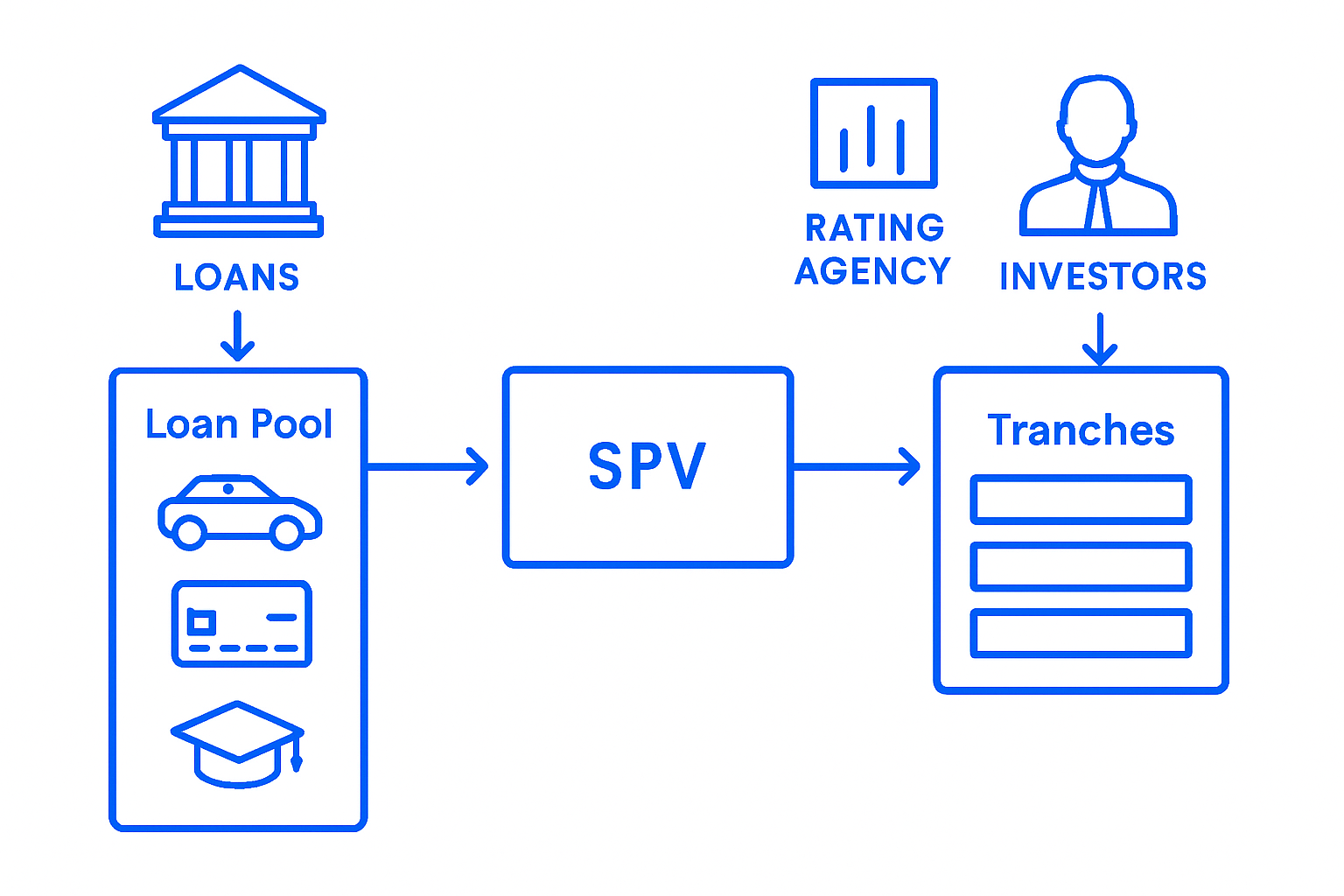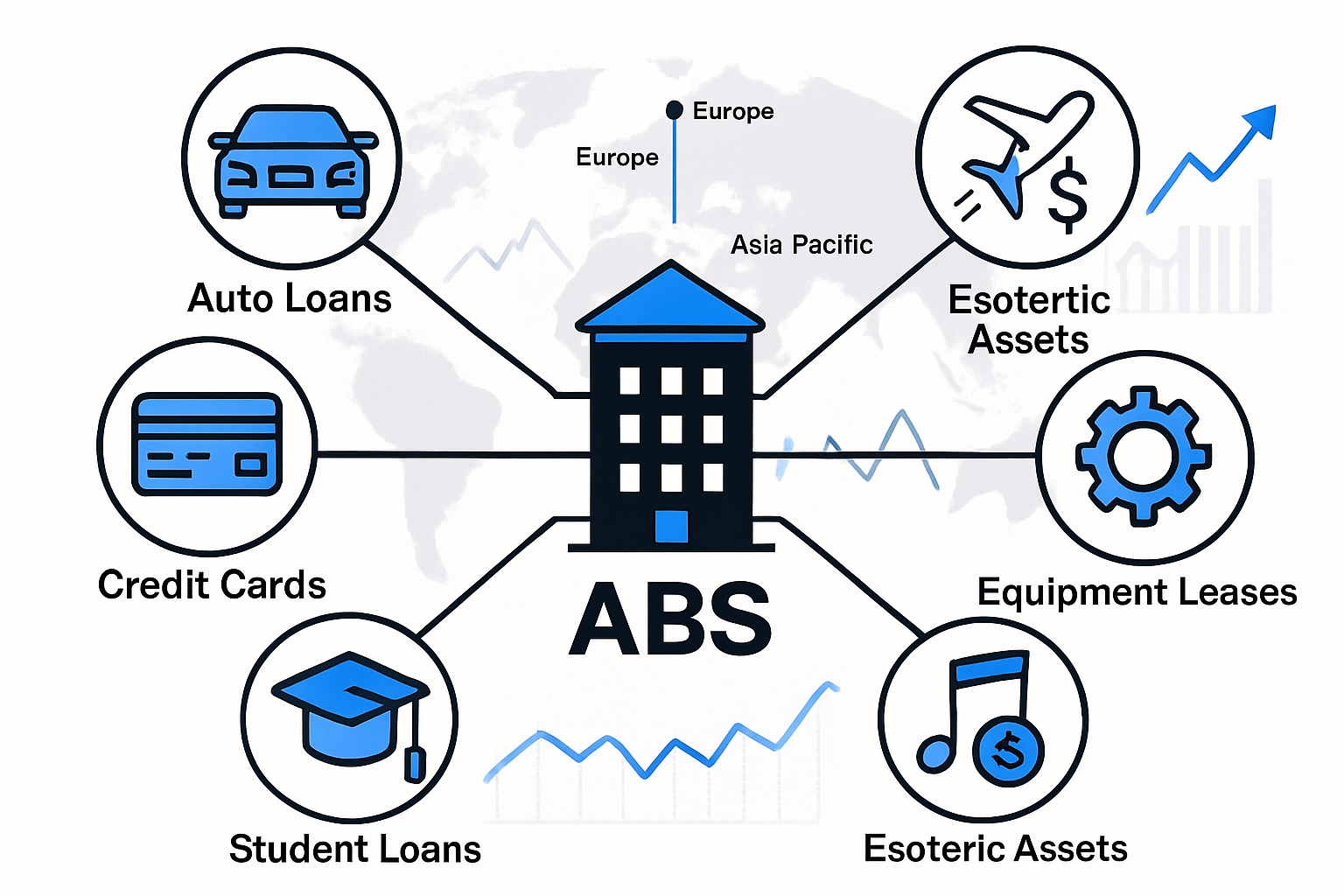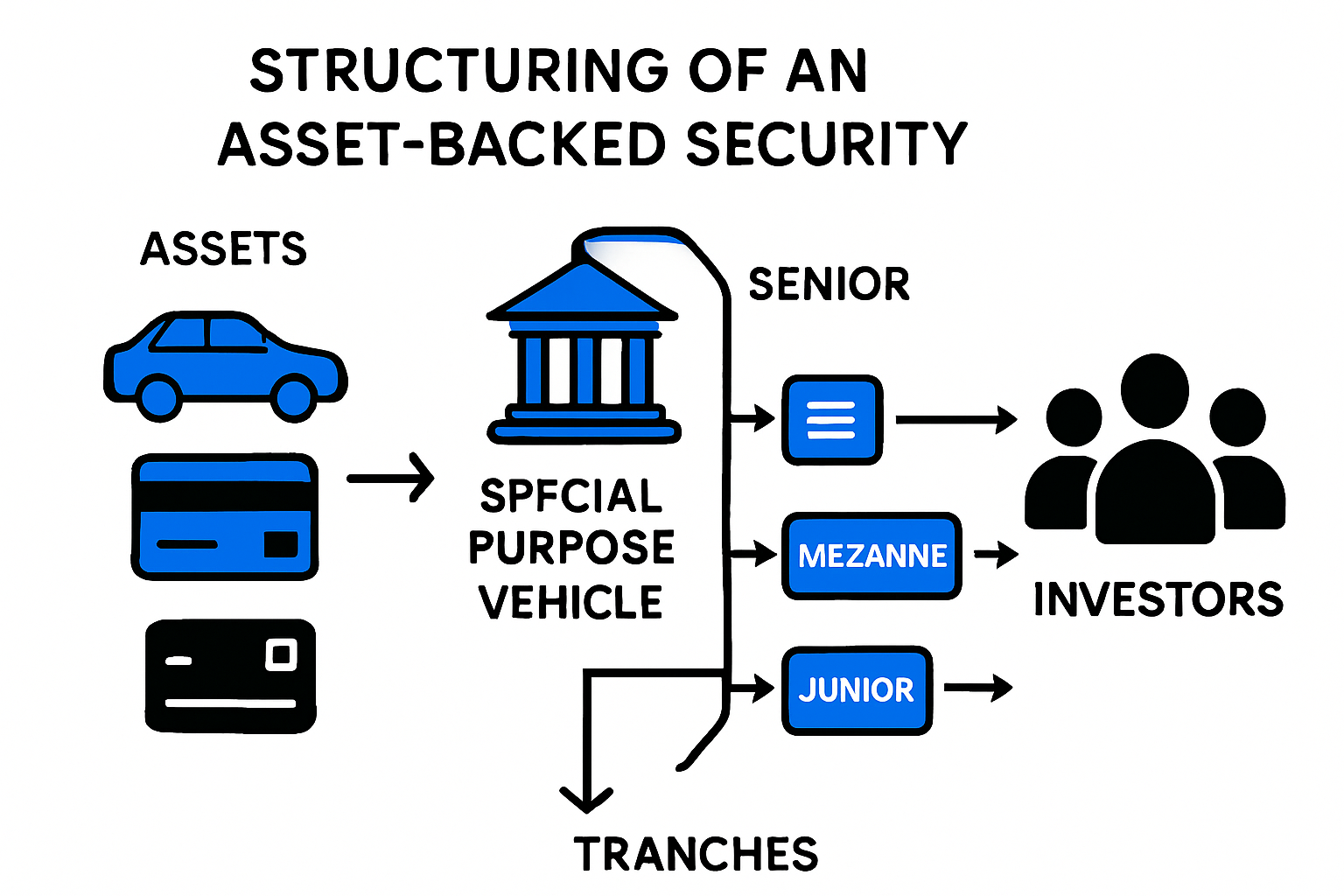Asset-Backed Security Guide: Insights and Strategies for 2025
In 2025, the asset-backed security market is making headlines as financial innovation accelerates and investors seek new ways to diversify. With issuance volumes surging and new asset classes emerging, understanding this complex market is more crucial than ever.
This guide will demystify the asset-backed security landscape, equipping you with actionable strategies and essential insights. Whether you are an investor, institution, or market participant, you will gain practical tools to navigate opportunities and risks.
Inside, you will find a clear overview of fundamentals, structures, trading dynamics, risk management, regulatory trends, and what lies ahead. Let’s unlock the potential of asset-backed security together.
Understanding Asset-Backed Securities: Fundamentals and Definitions
Asset-backed securities (ABS) have become a core feature of modern financial markets. To understand their growing impact, it's essential to break down what makes an asset-backed security unique, how these products are created, who participates in the market, and the balance of their benefits and risks.

What Are Asset-Backed Securities?
An asset-backed security is a financial instrument whose value and payments are derived from pools of underlying assets, such as credit card receivables, auto loans, or student loans. Unlike traditional bonds, which represent direct loans to companies or governments, an asset-backed security is collateralized by these pooled assets. This structure creates liquidity by turning illiquid assets into tradable securities.
For example, an auto loan ABS is backed by monthly car payments, while a corporate bond is backed by a company's general credit. Key terms include collateralization, tranches, and special-purpose vehicle (SPV). For definitions of these and other terms, see the Financial terms glossary. ABS play a pivotal role in diversifying risk and expanding investment opportunities.
The Securitization Process Explained
Creating an asset-backed security involves several steps. First, originators select and group assets—such as credit card receivables—based on quality and risk profile. These assets are then transferred to an SPV, which is a separate legal entity designed to isolate financial risk.
The SPV structures the ABS into tranches, each with different risk and return profiles. Once structured, the security is issued to investors. For example, a credit card ABS pools thousands of card balances, transferring payment risk from the originator to the SPV and then to investors. This process enables banks to manage risk and free up capital for new lending.
Key Players and Their Roles in the ABS Market
Several participants are critical to the asset-backed security market. Originators, such as banks and finance companies, create the underlying loans or assets. Underwriters package and market ABS offerings, ensuring they meet investor demand and regulatory requirements.
Rating agencies assess the credit quality of each tranche, providing independent evaluations. Investors, ranging from pension funds to hedge funds, purchase ABS for yield and diversification. Recently, fintech lenders have become significant originators, especially in the U.S. and Europe. This evolving landscape reflects a shift toward more diverse and innovative ABS issuers.
Advantages and Disadvantages of ABS
Asset-backed securities offer notable advantages. They provide liquidity to markets by transforming illiquid assets into tradable securities. ABS also enable risk transfer, portfolio diversification, and regulatory capital relief for originators.
However, ABS can be complex, sometimes lacking transparency. During the 2008 financial crisis, certain ABS performed poorly, highlighting the risks of inadequate due diligence and systemic exposure. Balancing yield and risk is crucial for investors, who must carefully analyze each asset-backed security before investing.
Types of Asset-Backed Securities in 2025: Market Breakdown
The asset-backed security market in 2025 is more diverse and dynamic than ever. Investors and institutions are encountering a broader range of ABS structures, asset pools, and regional variations, making it crucial to understand the evolving market landscape. Let’s break down the primary categories, emerging classes, regional trends, and highlight some notable recent deals.

Main Categories of ABS
The core of the asset-backed security market includes auto loan ABS, credit card ABS, student loan ABS, and equipment lease ABS. Each category pools similar receivables, transforming illiquid loans into tradable securities. Unlike mortgage-backed securities, which rely on residential or commercial mortgages, ABS utilizes a wider range of underlying assets.
| ABS Type | Typical Assets | 2025 Market Share (%) |
|---|---|---|
| Auto Loan ABS | Car loans/leases | 32 |
| Credit Card ABS | Card receivables | 28 |
| Student Loan ABS | Education loans | 17 |
| Equipment Lease | Business equipment | 13 |
| Other | Mixed/consumer loans | 10 |
According to the Asset-Backed Securities Market Report 2025, ABS issuance volumes remain robust, with notable growth in auto and equipment sectors. This data underscores the central role each asset-backed security type plays in portfolio construction.
Emerging and Niche ABS Classes
Beyond traditional categories, the asset-backed security market now features esoteric and niche classes, appealing to investors seeking diversification. Popular examples include:
- Aircraft lease ABS: Backed by revenues from leased airplanes.
- Royalty ABS: Streams from music, entertainment, or pharmaceutical royalties.
- Solar loan ABS: Cash flows from residential/commercial solar installations.
- Whole-business securitizations: Revenues from entire business franchises.
Royalty-backed asset-backed security deals have surged, particularly in the entertainment and pharma sectors. These non-traditional structures offer exposure to unique cash flows and often command higher yields, but they may involve more complex risk profiles and specialized expertise to evaluate.
Regional and Sectoral Trends
The asset-backed security market shows distinct regional flavors. In the U.S., ABS is dominated by consumer credit, with fintech-driven ABS seeing rapid growth. Europe has expanded its green and ESG-focused ABS, reflecting regulatory incentives and investor demand. Asia-Pacific markets, especially China and Australia, have increased ABS issuance in response to evolving consumer finance sectors.
Recent regulatory changes—such as enhanced disclosure requirements in the EU and risk retention rules in the U.S.—are shaping issuance patterns and investor participation. Green auto loan ABS and ESG-linked deals are gaining traction across all major regions, signaling a shift towards sustainability in the asset-backed security market.
Case Studies: Notable ABS Deals
Recent years have seen standout asset-backed security transactions. For instance, a record-setting auto loan ABS deal in 2024 featured innovative credit enhancement layers, allowing for tighter spreads and robust investor demand. Meanwhile, whole-business securitizations in the restaurant sector demonstrated how diverse revenue streams can bolster deal resilience.
Key lessons from these deals include:
- Innovative structuring can attract broader investor bases.
- Transparent reporting and strong servicing boost confidence.
- Market volatility highlights the importance of conservative underwriting.
By analyzing both successful and challenged asset-backed security issuances, market participants can adapt strategies and anticipate evolving risks.
Structuring and Issuing Asset-Backed Securities: Step-by-Step Guide
Getting the structure right is essential for any asset-backed security. This process ensures the underlying assets are packaged efficiently, risk is managed, and investors are protected. Let’s break down the journey from asset selection to issuance, highlighting the roles, techniques, and mechanics that define today’s ABS market.

Chronological Steps in ABS Structuring
Every asset-backed security starts with careful asset selection. Lenders or originators gather similar financial assets—think auto loans, credit card receivables, or equipment leases. These assets are pooled together to create a diversified foundation.
Next, a special-purpose vehicle (SPV) is established. The SPV purchases the asset pool, legally separating it from the originator’s balance sheet. Then, the structure is divided into tranches, each with distinct risk and return profiles. Rating agencies are brought in to assess the credit quality.
Here’s a quick overview:
- Identify and select eligible assets.
- Pool assets and analyze performance data.
- Create the SPV and transfer assets.
- Design tranches for various investor appetites.
- Engage rating agencies for due diligence.
Each step is crucial for building a robust asset-backed security that appeals to a range of investors.
The Role of Special-Purpose Vehicles (SPVs)
The SPV is the engine room of any asset-backed security. Legally, it acts as a bankruptcy-remote entity, meaning if the originator faces financial distress, the underlying assets remain protected.
By isolating assets within the SPV, investors gain confidence that their interests are shielded from the originator’s other obligations. For example, in an auto loan asset-backed security, the SPV holds the car loans, collects payments, and passes them to investors, independent of the car dealer or bank’s fate.
This setup is key for risk management, regulatory compliance, and maintaining transparency in every asset-backed security transaction.
Credit Enhancement Techniques
Investors want reassurance that an asset-backed security will deliver steady payments—even if some borrowers default. Credit enhancement techniques are built into the structure to boost creditworthiness and secure better ratings.
Common methods include:
- Overcollateralization (assets exceed liabilities)
- Reserve accounts (cash set aside for losses)
- Subordination (junior tranches absorb losses first)
- Insurance or third-party guarantees
For example, credit card ABS often use “excess spread”—the difference between interest collected and paid out—to cushion against defaults. These techniques make the asset-backed security more resilient, attracting a broader investor base.
Tranching and Payment Waterfalls
Tranching divides an asset-backed security into layers—senior, mezzanine, and junior—each with unique risk and return. The payment waterfall determines how cash flows are allocated.
Here’s how it works:
- Senior tranche: paid first, lowest risk, lowest yield
- Mezzanine tranche: paid next, moderate risk/yield
- Junior/equity tranche: paid last, absorbs losses, highest yield
Example payment waterfall (simplified):
1. Interest to senior tranche
2. Interest to mezzanine tranche
3. Interest/principal to junior tranche
In a student loan ABS, this tranching ensures senior investors are prioritized, making the asset-backed security structure appealing to both conservative and risk-seeking participants.
Pricing and Issuance Process
Pricing an asset-backed security depends on asset quality, tranche structure, and market demand. Issuers work with underwriters to set initial prices in the primary market, while existing ABS trade on secondary markets.
Factors such as credit ratings, collateral performance, and prevailing interest rates play a significant role. In 2024-2025, innovative structuring and investor appetite have influenced pricing trends, as highlighted in Seven Trends Defining Structured Finance in 2025.
Understanding these dynamics helps issuers optimize structures and enables investors to identify value in the asset-backed security market.
Trading, Investing, and Risk Management in the ABS Market
Navigating the asset-backed security market in 2025 requires a clear understanding of trading mechanics, investment evaluation, risk factors, and mitigation strategies. As the ABS landscape expands, both new and seasoned investors need practical insights to make informed decisions.

How ABS Are Traded
The asset-backed security market operates across both primary and secondary platforms. In the primary market, new ABS deals are brought to market by underwriters and sold to institutional investors. The secondary market, meanwhile, features ongoing trading through dealer networks and over-the-counter (OTC) transactions.
Liquidity varies by ABS type. Auto loan and credit card ABS generally offer higher liquidity compared to more esoteric classes. Electronic trading platforms are increasingly common, improving price discovery and execution speed. For a deeper dive into recent trading dynamics and expert perspectives, consider exploring Key Trends in U.S. Securitized Fixed Income 2025.
Evaluating ABS Investments: Key Metrics and Analysis
Before investing in an asset-backed security, investors should analyze several key metrics:
- Yield: Indicates expected return, factoring in risk and structure.
- Duration: Measures interest rate sensitivity.
- Credit rating: Reflects underlying asset quality and structure.
- Asset pool performance: Historical data and stress tests reveal resilience.
For example, auto loan ABS may offer attractive yields but shorter durations, while credit card ABS often demonstrate stable performance. Comparing these metrics enables investors to select the most suitable asset-backed security for their risk-return profile.
Risks Associated with ABS
Every asset-backed security carries inherent risks. The main categories include:
- Credit risk: Borrower defaults within the asset pool.
- Prepayment risk: Early repayment of underlying loans affecting cash flow.
- Interest rate risk: Value changes due to market rate shifts.
- Liquidity risk: Difficulty selling less common ABS types.
- Operational risk: Issues with servicer performance or data integrity.
The 2008 financial crisis underscored the importance of understanding these risks. Default and loss rates vary by ABS type, making due diligence essential when considering any asset-backed security.
Risk Mitigation Strategies for Investors
Investors can manage asset-backed security risks through several strategies:
- Diversification: Spreading investments across different ABS classes and issuers.
- Due diligence: Thoroughly analyzing asset pools, structures, and servicers.
- Credit enhancements: Relying on features like excess spread or subordination.
- Ongoing monitoring: Tracking asset performance and servicing quality.
Institutional investors in 2025 increasingly use advanced analytics to monitor exposure and react to market changes, helping them maintain a balanced approach to asset-backed security investing.
ABS Indices and Benchmarks
Major indices, such as the ABX and Markit, track the performance of the asset-backed security market. These benchmarks enable investors to:
- Monitor ABS market trends.
- Compare individual ABS performance to the broader market.
- Assess risk and diversification benefits.
For example, ABS index returns over recent years highlight the resilience and evolving nature of the market, making them valuable tools for both passive and active investors evaluating asset-backed security allocations.
Regulatory Environment and Compliance Trends for ABS in 2025
The asset-backed security market is navigating a wave of regulatory change in 2025. Recent reforms aim to strengthen investor protection and market stability, while also encouraging innovation. As global markets evolve, understanding the compliance landscape is critical for anyone involved in asset-backed security issuance, investment, or analysis.
Recent Regulatory Developments
Recent years have brought significant updates to asset-backed security regulation worldwide. Basel III and IV frameworks have tightened capital requirements for banks, directly influencing how ABS are structured and held. In the U.S., Dodd-Frank provisions enforce risk retention rules, requiring issuers to keep "skin in the game." The EU Securitization Regulation has introduced new disclosure and due diligence standards.
These changes aim to boost confidence in the asset-backed security sector by making risks more transparent and aligning incentives between issuers and investors. For example, risk retention ensures originators remain exposed to a portion of risk, discouraging reckless lending practices. Staying compliant with these evolving rules is now a top priority for market participants.
Transparency and Reporting Standards
Transparency has become a cornerstone of the asset-backed security market. Regulators now demand granular reporting on underlying asset pools and deal structures. Standardized loan-level data is increasingly required in both Europe and the U.S., helping investors conduct more thorough due diligence.
This shift improves comparability across asset-backed security offerings and supports better risk assessment. Enhanced reporting practices also pave the way for advanced analytics and stress testing. Ultimately, these changes foster greater investor trust and market resilience by making complex ABS structures easier to understand.
ESG Considerations in ABS
Environmental, social, and governance (ESG) factors are reshaping the asset-backed security landscape. Issuers are now structuring green and social ABS to meet growing demand for responsible investing. Criteria such as renewable energy usage, social impact, and transparent governance are being embedded into deal documentation.
Green auto loan ABS and solar loan ABS are prime examples of this trend. Investors increasingly evaluate asset-backed security deals not just for yield, but also for their ESG credentials. As a result, ESG considerations are influencing both the structuring and marketing of ABS products, and regulators are beginning to develop specific guidelines for these innovative securities.
Regulatory Outlook for 2025 and Beyond
Looking ahead, regulatory oversight of the asset-backed security market is expected to intensify. Anticipated reforms include stricter reporting standards and expanded ESG disclosure requirements. Some experts argue these measures will support sustainable market growth, while others caution against overregulation.
Projected ABS issuance remains robust under current regimes, but market participants must stay agile. For a deeper dive into performance expectations and regulatory shifts, check out the Structured Products 2025 Outlook. Keeping pace with compliance trends will be crucial for success in the evolving asset-backed security market.
The Future of Asset-Backed Securities: Trends, Innovations, and Strategic Insights
The asset-backed security landscape is undergoing a remarkable transformation as we approach 2025. Technological advances, changing investor preferences, and evolving regulations are shaping the future of this market. Whether you are an investor, issuer, or financial professional, understanding these trends is vital for making informed decisions and staying ahead in a competitive environment.
Technological Innovations Shaping ABS
Technology is rapidly redefining the asset-backed security market. Blockchain and smart contracts are making securitization more transparent and efficient, enabling real-time settlement and tamper-proof records. Artificial intelligence is powering advanced credit analysis and risk modeling, improving both origination and ongoing surveillance of ABS pools. A notable example is the recent pilot transactions using blockchain for ABS issuance, which demonstrated faster execution and enhanced investor confidence.
These innovations are lowering operational costs and reducing human error. As digitalization continues, the asset-backed security market is expected to become more accessible and resilient, with technology acting as both a catalyst and a safeguard.
Market Growth Drivers and Challenges
Multiple factors are fueling the growth of the asset-backed security market. Rising interest rates, increased consumer credit demand, and the search for yield have made ABS an attractive option for investors. The expansion of fintech and alternative lending platforms is also adding new types of assets to the securitization pipeline.
However, challenges remain. Regulatory uncertainty, market volatility, and the growing risk of cyberattacks can disrupt the market. According to recent projections, global ABS issuance is set to grow in 2025, but participants must remain vigilant and agile to navigate these headwinds and seize opportunities.
Strategic Approaches for Issuers and Investors
Success in the asset-backed security market requires a strategic mindset. Issuers should focus on robust asset selection, transparent structuring, and effective risk management. Investors, meanwhile, must conduct thorough due diligence, analyze credit enhancements, and monitor ongoing performance. Evaluating the debt-to-equity ratio in finance can provide valuable insight when assessing ABS issuers’ financial health and risk profile.
Institutional investors are increasingly optimizing their allocations to ABS, balancing risk and reward by diversifying across asset classes and maturities. Staying informed about market developments and regulatory changes is essential for both issuers and investors.
Lessons from Historical Market Events
History offers important lessons for anyone involved in asset-backed security investing. The 2008 financial crisis revealed the dangers of opaque structures and poor underwriting, leading to significant reforms and increased scrutiny. Since then, the market has implemented tighter regulations, improved transparency, and more rigorous risk assessment processes.
These changes have made the asset-backed security sector more robust and resilient. The recovery and sustained growth in recent years reflect a greater focus on quality and investor protection, helping to restore confidence and attract new participants to the market.
The Role of ABS in Portfolio Diversification
Asset-backed security investments can play a pivotal role in portfolio diversification. ABS often exhibit unique risk-return profiles compared to corporate bonds or equities, helping to reduce overall portfolio volatility. Many investors compare ABS to understanding floating rate securities, as both can offer protection against rising rates and provide steady cash flows.
By allocating a portion of assets to ABS, investors can gain exposure to consumer credit, auto loans, and other sectors not directly accessible through traditional securities. Historical data shows that balanced portfolios with ABS allocations have delivered competitive returns with manageable risk.
Predictions and Expert Insights for 2025
Looking ahead, experts predict continued growth and innovation in the asset-backed security market. New asset classes—such as green loans, fintech-originated assets, and even digital revenue streams—are likely to emerge. The sustainability of current trends will depend on regulatory responses, technological progress, and the ability of market participants to adapt.
While competition will intensify, those who leverage data-driven strategies and stay alert to market shifts will find opportunities. The asset-backed security sector’s adaptability and resilience suggest a bright future for both issuers and investors.
Now that you have a clearer understanding of how asset-backed securities are evolving and what to watch for in 2025, imagine exploring these market shifts through the lens of history. With our platform, you can dive into interactive charts, discover AI-powered summaries, and truly get the story behind every market move—helping you spot patterns and make smarter decisions. If you’re as curious as we are about connecting past events to future opportunities, this is your chance to be part of something unique. Join Our Beta and help us shape the next generation of financial insights.
